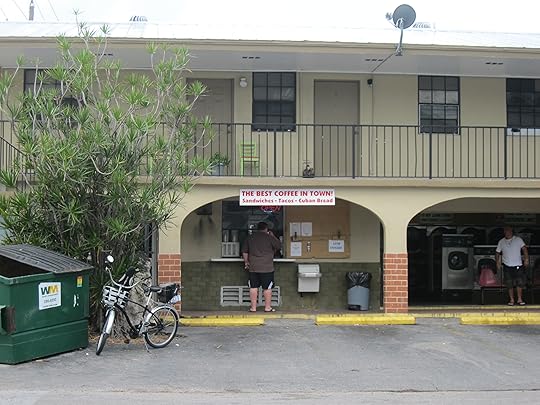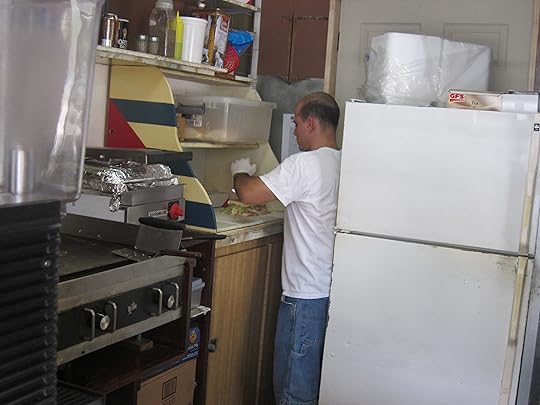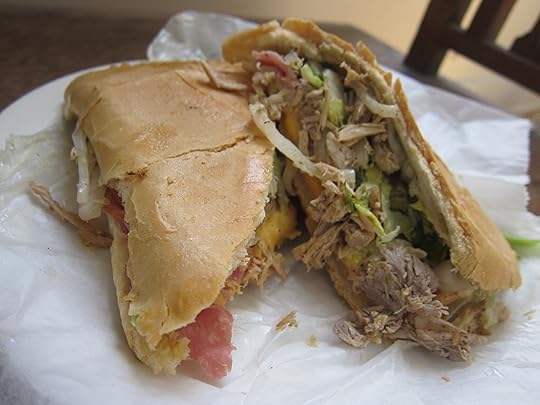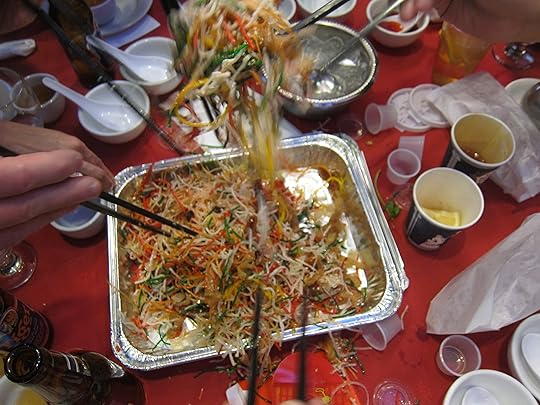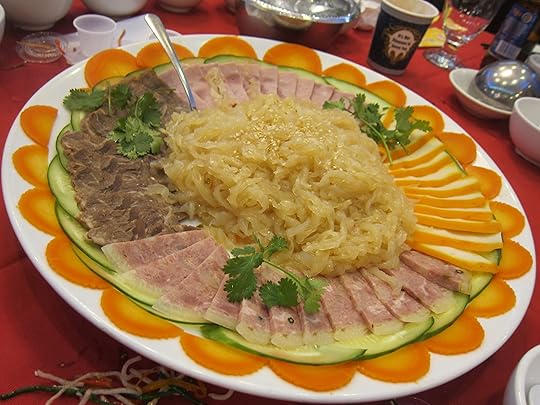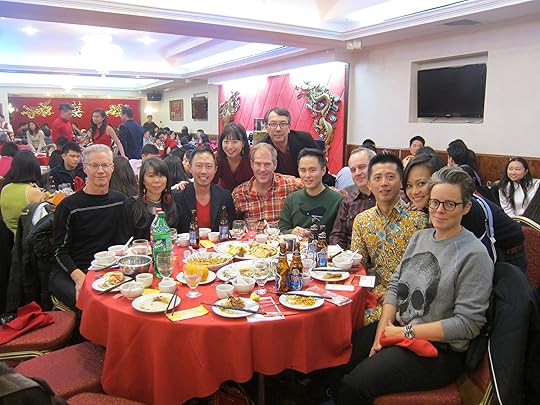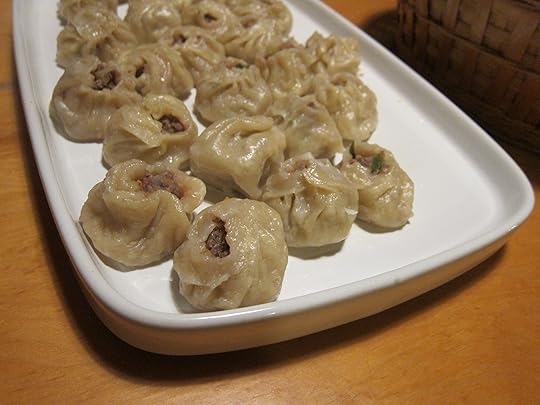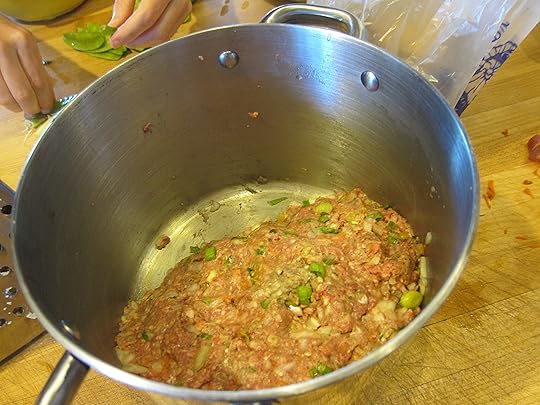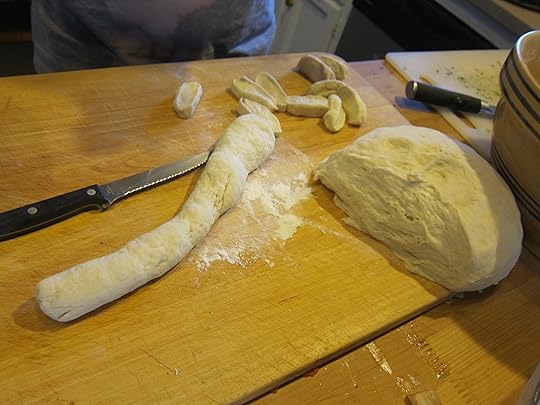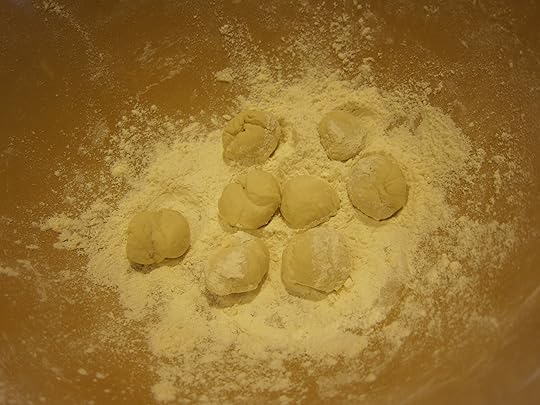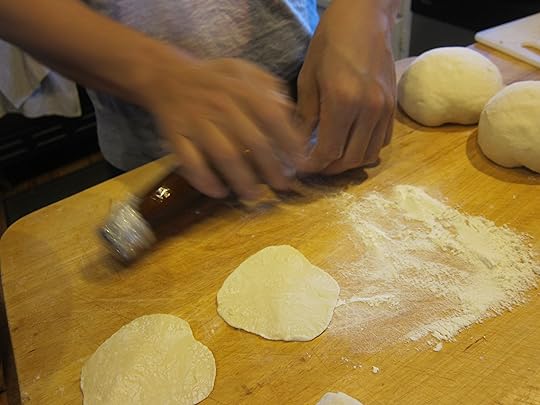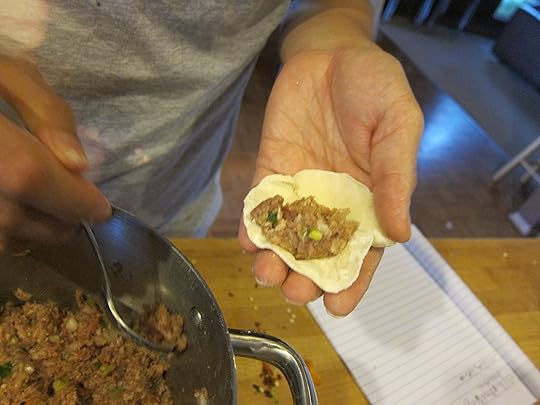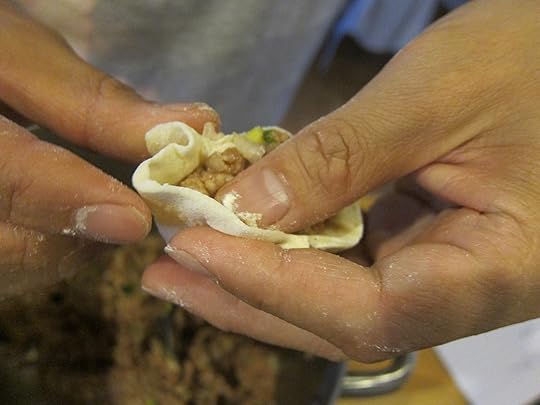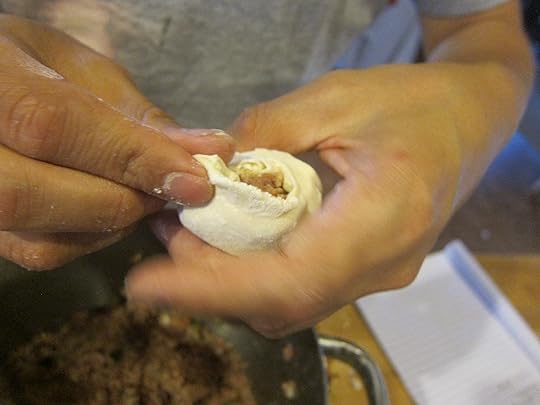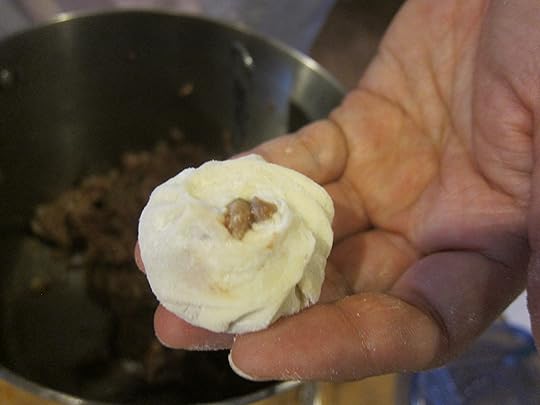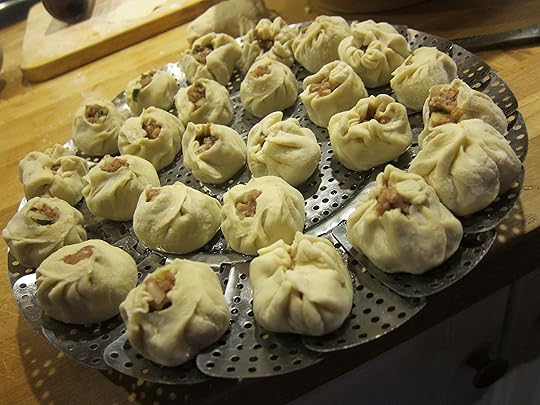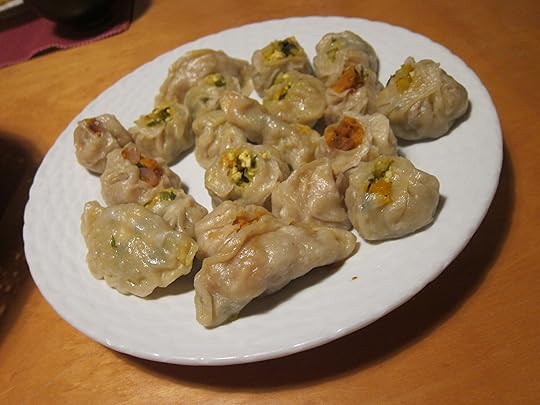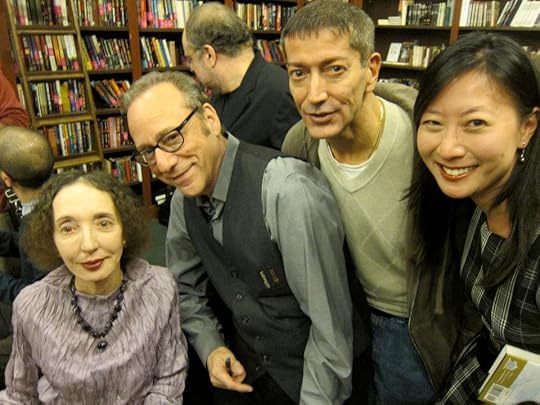Cheryl Lu-Lien Tan's Blog, page 4
April 13, 2013
White Street Sandwich Shop (Key West): A Cuban Coffee Must
First night in Key West and the locals are determined to school this food writer. The most important advice?
“The best places to get Cuban coffee are attached to laundromats.”
Sure, there’s Sandy’s — a place so well-known it’s got sleek rides pulling up all day to pick up trays of coffees to go along with giant bags of sandwiches and a fleet of delivery cars whizzing in and out as you wait 20 minutes for your order. But the one that people keep saying is the must is a little less celebrated.
Beloved as this place is, its name escapes them. “Just go to the corner of Union and White,” I am told.
And so on a sunny Saturday morning, taking a little break from my writing desk, I do …
Located in a quieter, more residential bit of town, this is not a place that seems to attract many tourists — a fact that’s just fine with me.
It’s hard to miss White Street Sandwich Shop even though it’s a tiny dive — not just because of its sign announcing that it has “The Best Coffee In Town.” There are also the benches of men slouched by the laundromat, sipping coffee, watching the day unfurl.
The menu is simple — you can get Cuban toast with butter ($1.25), a range of breakfast sandwiches ($4 to $8.50) as well as housemade guava pastelitos ($1.50), tacos ($10) and of course, Cuban sandwiches ($8).
Sergei is the one-man show here — and you can watch him assemble your sandwich through the small window.
First, he places ham, cheese and salami in Cuban bread and grills it, then fries up some pork with onions, then puts that all together with shredded lettuce, pickles and tomato.
This takes a while so you might as well have some coffee while it’s happening. (This is the best place for it, after all.)
I order a cafe con leche ($1.50 to $2.50, depending on the size) — iced, because summer seems to have arrived early in the Keys this year. And it is delicious. Intensely flavored, slightly sweet, frothy and cold — this coffee hits the spot. I almost wish I’d gotten it hot so I could taste the coffee full on.
As for Sergei’s mammoth sandwich, this photo says it all. Each bite was fantastic, packed with the punchy mix of oniony pork, ham, salty cheese, pickles and a tangy sauce.
Will I return? Hell, yeah. I don’t care if it’s 100 degrees that day though — hot cafe con leche it’ll be.
White Street Sandwich Shop, 1222 White Street, Key West, Fla.; 305.797.6871
March 15, 2013
Barley Water: Daffodils, Spring & An Ode to Mary
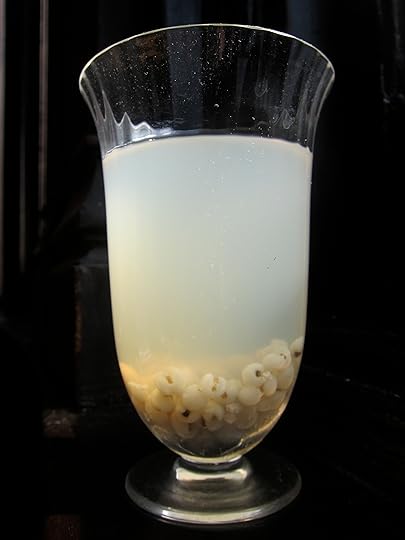 Cancer has been on my mind a fair bit recently — not too many mornings ago, I awoke to the worst news. A dear friend and longtime mentor had passed away. Another victim of breast cancer.
Cancer has been on my mind a fair bit recently — not too many mornings ago, I awoke to the worst news. A dear friend and longtime mentor had passed away. Another victim of breast cancer.
The world knows Mary Corey as many things — the first female editor of the Baltimore Sun, an elegant writer and intrepid reporter who covered breaking national news and fashion’s frothy runway shows with equal aplomb, a graceful leader of a major regional newsroom at a time of great tumult in journalism.
But I simply know Mary as just about the best boss anyone could have asked for — and an intensely big-hearted friend.
Mary was my editor in my years as a young features reporter — she pushed me to think big and nudged the (then) very-reluctant me into covering fashion, sparking a career path that I’m on to this day. It would be an understatement to say that I would not be the writer I am today without Mary.
By all accounts, even as cancer overtook her life, Mary remained as sunny as ever, still thinking of others above herself. That was just the way she was — big sister to everyone, no matter the circumstance.
So when my Let’s Lunch international lunch club — inspired by cancer survivor Karen at GeoFooding — decided to post a dish today inspired by spring, life and daffodils to promote cancer awareness, I jumped right in.
Mary, this one’s for you …
Mary loved cookies — and I loved baking cookies and sharing them with her. (The last time I visited her in the Sun newsroom a few years ago, I brought her a box of these lemon thumbprint cookies.) Some of my fondest memories of working at the Sun involve late nights with Mary. Since we were both night owls, there was many a night in the Sun newsroom when we were among the last to leave — me writing, she editing, both of us trading messages and snacks until the night copy-editors started packing up.
I’ve had little time to bake recently, however, so I decided to turn to something simple that I find myself thinking of when the weather warms up: my mother’s barley water.
This is a drink that my mother loves to brew whenever she feels things are getting too “heaty” — it’s supposed to cool you down a little and is perfect, iced, on a warm spring day or served piping hot if you’re down with a cold.
I’ve never known whether to believe in its actual healing properties but I do feel rejuvenated after a glass. So with all this in mind and spring around the corner, here’s a little recipe for Singaporean-style barley water.
Cheers to spring, to daffodils and of course, to Mary. I miss you, dear.
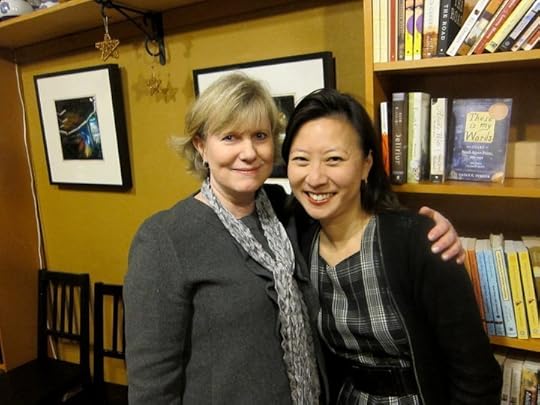 If you knew Mary — or even if you didn’t — her family suggests donations to one or more of the following charitable entities:
If you knew Mary — or even if you didn’t — her family suggests donations to one or more of the following charitable entities:
John Fetting Research Fund
C/O Dina Mallis Klicos
Johns Hopkins Kimmel Cancer Center
100 N. Charles Street, Suite 234
Baltimore, Maryland 21201
HopeWell Cancer Support
10628 Falls Road
Lutherville, Maryland 21093
http://www.hopewellcancersupport.org/How-to-Give
The Red Devils
5820 York Road, Suite 200
Baltimore, Maryland 21212
http://www.the-red-devils.org/
~~~
Don’t forget to check out other Let’s Lunchers’ daffodil/spring/life dishes below! And if you’d like to join Let’s Lunch, go to Twitter and post a message with the hashtag #Letslunch — or, post a comment below.
Annabelle‘s Red Pepper and Eggplant Confit at Glass of Fancy
Anne Marie‘s Zihuatanejo (Or Veal Shank Redemption Sammy) at Sandwich Surprise
Grace‘s Meyer Lemon and Mandarin Citrus Bundt Cake at HapaMama
Karen‘s Wasabi Tuna Steak at GeoFooding
Linda‘s Brassica Fried Rice at Spicebox Travels
Lisa‘s Salad of Chargrilled Sourdough, Tomato and Haloumi Cheese at Monday Morning Cooking Club
Lucy‘s Carrot Souffle at A Cook and Her Books
Monica‘s Roses and Eggplant at A Life of Spice
Nancie‘s Shad Roe Southern Style at Nancie McDermott
Rebecca‘s Goat Cheese Panna Cotta with Mango Foam at Grongar Blog
~~~
Singaporean Barley Water
Ingredients:
250 grams dried pearl barley
2.5 liters water
100 grams rock sugar (or more, to taste)
Directions:
Wash barley thoroughly then place in a pot. Add water and rock sugar to the pot and bring contents to a boil.
Cover and let it simmer for 45 minutes to an hour — less if you prefer clearer water; more if you like it a little thicker. Toward the end, taste and add more sugar if you’d like. Strain and serve warm or chilled.
February 17, 2013
Royal Seafood: A Singaporean Chinese New Year Feast
It’s difficult being far from home at the holidays — which is what makes February a trying time most years.
Living in New York, far from the Chinese new year feasts and festivities of Singapore, I always feel like I’m missing out. Thankfully, though, there was a special dinner this year — on the seventh day of the lunar new year no less. Now, the seventh day is the day that Chinese celebrate as “Ren Ri,” the day that humans were created. (According to Chinese mythology, the first life-form the goddess Nu Wa created on the first day of the year was the chicken — go figure.) And since it’s the birthday of humans, the Chinese celebrate it as everybody’s birthday.
So it seemed fitting to be heading out to a Chinese new year celebration at Royal Seafood in New York on a day that we could toast everybody’s birthday …
Since this wasn’t just any Chinese new year dinner but one organized by the New York Singapore Association, there was a spread of Singapore baked goods and snacks to kick off the evening.
I ignored most of the offerings — a 10-course dinner lay before me, after all — but couldn’t resist the homemade pineapple tarts. I’d been craving them for days — if you’ve been following this blog or have read “A Tiger in the Kitchen,” you’ll know that I feel incomplete if I’ve gone more than a few months without having these treats cross my lips.
These buttery cookies topped with cinnamon- and pandan leaf-scented pineapple jam are a major Chinese new year offering in Singapore. Because pineapples are gold, these cookies are seen as very lucky. Also, they’re pretty darn delicious.
Having been bereft over not having any tarts this year, the sight of these almost made me cry. (They were mighty tasty, too — or as my people say: “Shiok!”)
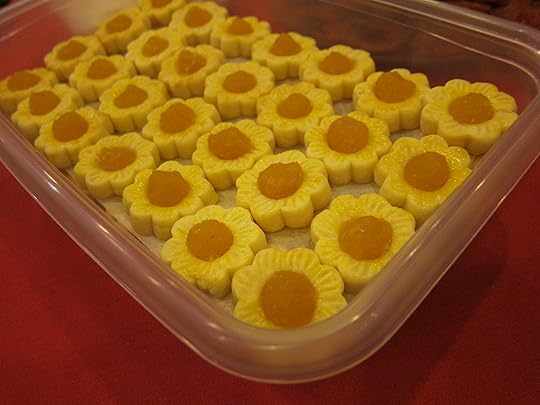 The meal began with another Singaporean tradition — yu sheng, a salad of raw fish and more than 10 other ingredients, each of which symbolizes an aspect of luck or good fortune for the year. Chopped peanuts, for example, represent gold ingots; plum sauce is supposed to forecast sweetness for the year ahead. (I explain all this a little more in “A Tiger in the Kitchen.”)
The meal began with another Singaporean tradition — yu sheng, a salad of raw fish and more than 10 other ingredients, each of which symbolizes an aspect of luck or good fortune for the year. Chopped peanuts, for example, represent gold ingots; plum sauce is supposed to forecast sweetness for the year ahead. (I explain all this a little more in “A Tiger in the Kitchen.”)
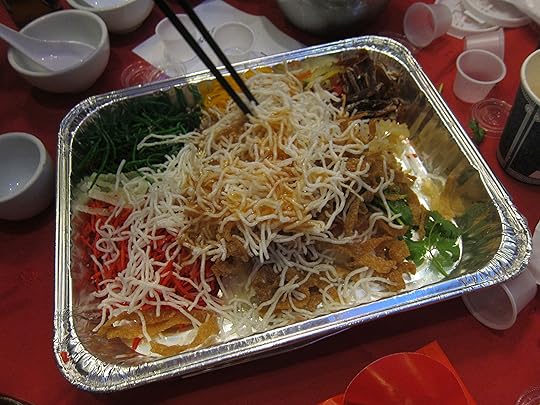 As you add each ingredient, you’re supposed to shout out the cheng yu (old Chinese saying) that conveys this wish. When adding the plum sauce, for example, you’re supposed to announce “Tian tian mi mi,” which means “sweet as honey.” When the raw fish goes in, you yell “Nian nian you yu,” wishing you wealth for the year. (The Chinese word for “fish” is a homophone for “wealth.”)
As you add each ingredient, you’re supposed to shout out the cheng yu (old Chinese saying) that conveys this wish. When adding the plum sauce, for example, you’re supposed to announce “Tian tian mi mi,” which means “sweet as honey.” When the raw fish goes in, you yell “Nian nian you yu,” wishing you wealth for the year. (The Chinese word for “fish” is a homophone for “wealth.”)
Since my table was filled with a rather untraditional lot — and none of our parents were around to say each chengyu — we had to look up all of these on our iPhones as we went along.
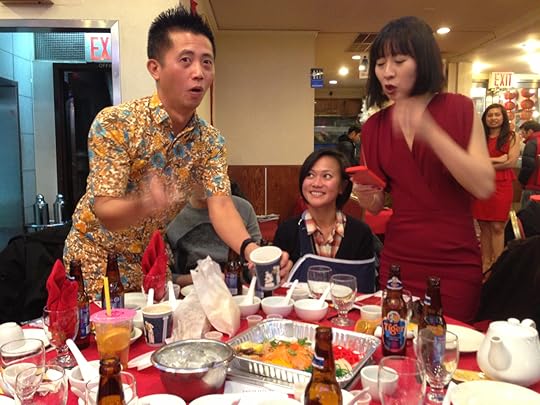 Once all of that was done, everyone stood up, gathered around the table and tossed the salad up with their chopsticks, flinging the food as high up as we could. The higher the salad went, the greater our success and luck would be in the coming year.
Once all of that was done, everyone stood up, gathered around the table and tossed the salad up with their chopsticks, flinging the food as high up as we could. The higher the salad went, the greater our success and luck would be in the coming year.
After that, we were onto the rest of the 10-course meal.
Now, I’d never been to Royal Seafood before — it did get an OK review in the New York Times in December. (The article noted that the restaurant’s co-owner and chef Kendy Cheng is from Hong Kong — land of amazing food.)
Our meal, however, was not amazing. Entertaining and thoroughly delightful yes — and certainly not terrible for one prepared for 290 people — but there were hits and misses among the dishes.
The traditional cold plate appetizer — jellyfish salad, cold cuts of pork and cuttlefish — was basic.
We were excited about the scallops with XO sauce — only to not detect much or any XO sauce in the dish. When we asked our waiter about it, he said the XO sauce was coming, that it would be served separately. (Highly unusual for this dish.)
After it didn’t appear, we started eating. Good thing, too — the sauce never arrived.
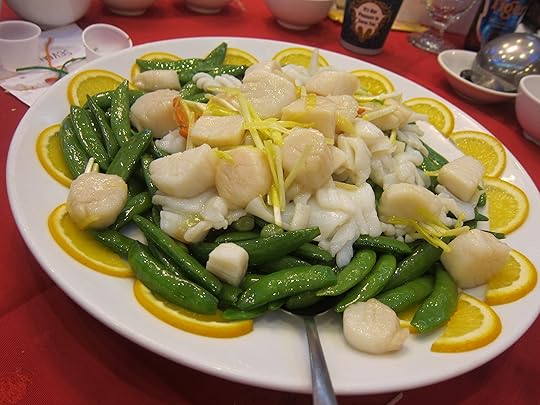 The house walnut shrimp was very nicely fried — we left the bed of warm and slightly greasy mayo-tossed melon largely untouched.
The house walnut shrimp was very nicely fried — we left the bed of warm and slightly greasy mayo-tossed melon largely untouched.
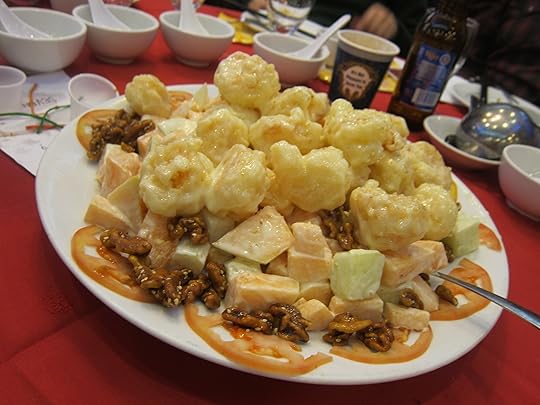 The crab meat soup with dried bamboo shoot was clearly meant to be a substitute for shark’s fin. Even with the addition of a hefty amount of tart red vinegar, the soup largely tasted like watery corn starch.
The crab meat soup with dried bamboo shoot was clearly meant to be a substitute for shark’s fin. Even with the addition of a hefty amount of tart red vinegar, the soup largely tasted like watery corn starch.
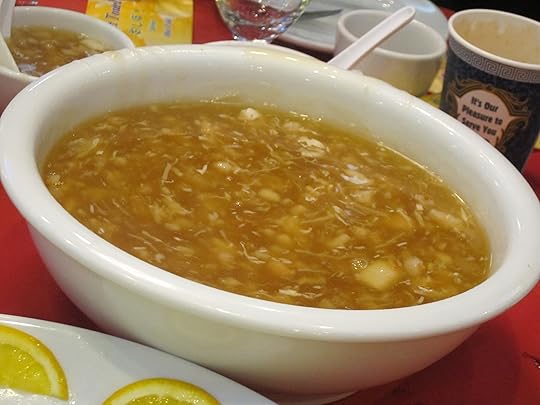 The abalone with bok choy and Chinese mushrooms was nicely done — the vegetables in this dish and the scallop dish, by the way, were just terrific. Very sweet and cooked to just the right amount of crispness.
The abalone with bok choy and Chinese mushrooms was nicely done — the vegetables in this dish and the scallop dish, by the way, were just terrific. Very sweet and cooked to just the right amount of crispness.
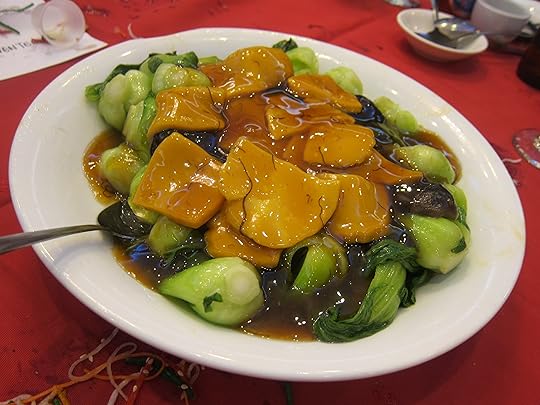 The lobster with ginger and scallion was perfectly fine. Although the lobster is the hallmark of this restaurant, it was not much to write home about. (It had me craving the lobster typhoon at Wong Restaurant, in fact — a lobster dish that comes slathered with a spicy garlic-flecked sauce and peppered with crunchy soy-sauce minced pork.)
The lobster with ginger and scallion was perfectly fine. Although the lobster is the hallmark of this restaurant, it was not much to write home about. (It had me craving the lobster typhoon at Wong Restaurant, in fact — a lobster dish that comes slathered with a spicy garlic-flecked sauce and peppered with crunchy soy-sauce minced pork.)
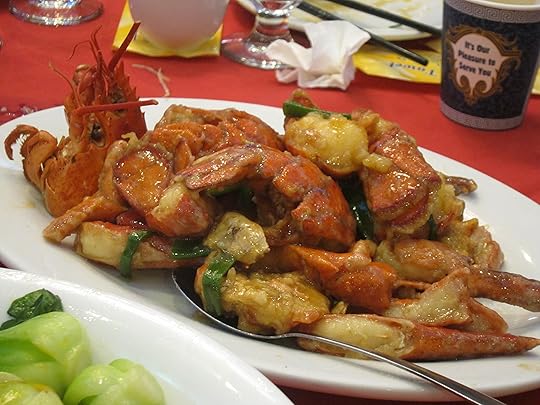 Now the chicken — the least sexy of all the dishes on the menu — blew my mind. Hong Kong-style crispy-skinned chicken is one of my absolute favorite things and this was an outstanding version.
Now the chicken — the least sexy of all the dishes on the menu — blew my mind. Hong Kong-style crispy-skinned chicken is one of my absolute favorite things and this was an outstanding version.
The skin was so crisp it crackled in my mouth like umami chips yet the meat of the chicken was so juicy and tender I felt like I was biting into little pillows.
In Singapore, this dish is served with keropok — a salty prawn cracker. I’m guessing they’re hard to find in New York because we got our chicken with Pringles, which turned out to be not a bad accompaniment. (Everything is better with Pringles, it turns out.)
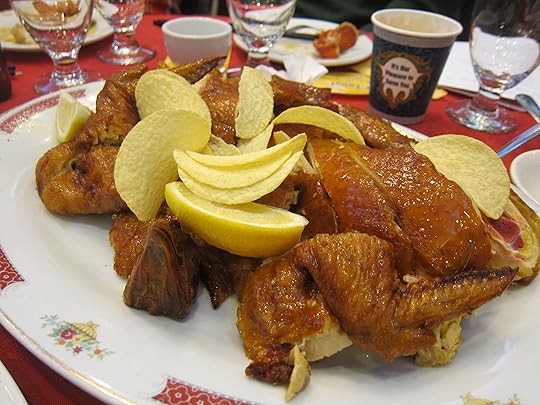 As we were recovering from the chicken, another flavor bomb arrived — steamed fresh fish Shanghai style. This dish was outstanding — the fish was so juicy and tasty and the gingery soy-sauce-fish juice gravy was so delicious I wanted to drink it with a spoon.
As we were recovering from the chicken, another flavor bomb arrived — steamed fresh fish Shanghai style. This dish was outstanding — the fish was so juicy and tasty and the gingery soy-sauce-fish juice gravy was so delicious I wanted to drink it with a spoon.
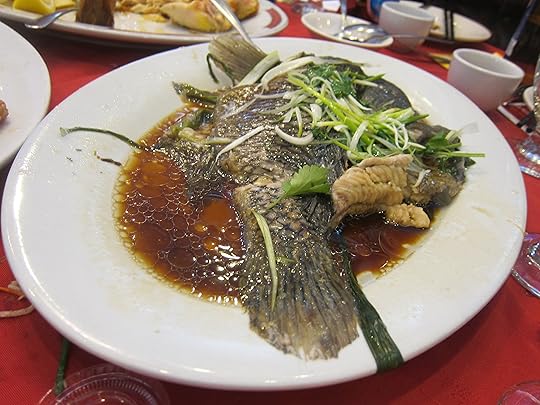 After all that, I didn’t think a basic plate of noodles could wow me but this one did. These stir-fried E-Fu noodles — eaten for longevity — were perfectly al dente, very nicely friend and especially tasty with the fish gravy drizzled over it.
After all that, I didn’t think a basic plate of noodles could wow me but this one did. These stir-fried E-Fu noodles — eaten for longevity — were perfectly al dente, very nicely friend and especially tasty with the fish gravy drizzled over it.
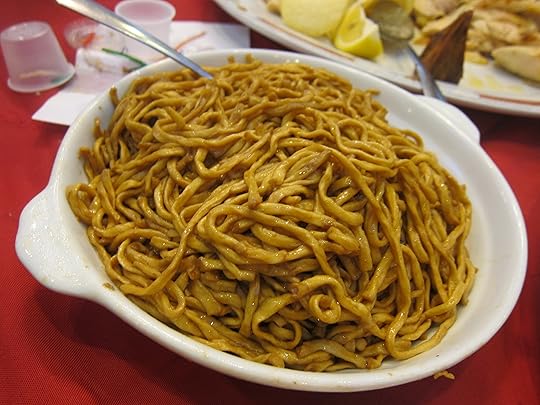 Was it the most perfect meal? No — but with a few knockout dishes, the company of Singaporeans and pineapple tarts to toast the new year, this sojourner certainly had no complaints.
Was it the most perfect meal? No — but with a few knockout dishes, the company of Singaporeans and pineapple tarts to toast the new year, this sojourner certainly had no complaints.
Happy year of the snake!
Royal Seafood, 103 Mott St, New York, NY 10013; 212.219.2338
February 12, 2013
River South (Hoe Nam) Prawn Noodles: Rainy Day Fukienese
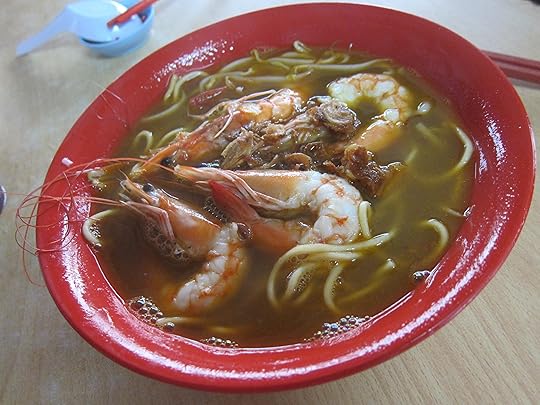 Snow, biting winds, ice chips pelting my windows — last weekend’s storm in New York City has had me wondering why I don’t just throw in the towel each winter and decamp to tropical Singapore.
Snow, biting winds, ice chips pelting my windows — last weekend’s storm in New York City has had me wondering why I don’t just throw in the towel each winter and decamp to tropical Singapore.
What has gotten me through these past few freezing, sloshy days however, is my intense memory of and cravings for Singapore noodle soups.
These are harder to find in cosmopolitan New York than you’d think. Sure, Cantonese wonton soups and phos are everywhere. But beefy Teochew broths spiked with star anise or rich Hainanese curried noodle soups? I actually have never seen those on menus around here.
So when the weather starts turning in New York, the cravings begin. Which is how I haven’t been able to get Hoe Nam prawn noodles out of my head …
In Singapore, my desire for Hoe Nam (as it’s called, even though its official name is River South) typically arises on chilly rainy days. On a recent trip home during monsoon season, when the rains began, my friend Jeanette texted me to meet her there.
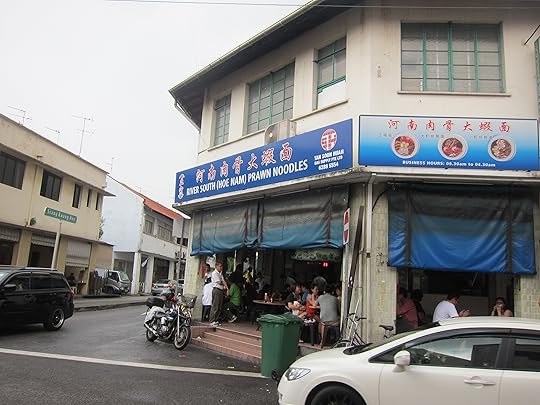 For a hawker, this is a pretty impressive setup — the operation occupies an entire corner kopitiam (coffeeshop) space in Singapore’s Macpherson neighborhood. (Usually, a different hawker rents each stall.)
For a hawker, this is a pretty impressive setup — the operation occupies an entire corner kopitiam (coffeeshop) space in Singapore’s Macpherson neighborhood. (Usually, a different hawker rents each stall.)
Hoe Nam, however, is so famous for its Hokkien (Fukienese) prawn noodles that people travel from all over the island just for a fix. So even though we got there well after the lunch hour on a weekday, the place was packed.
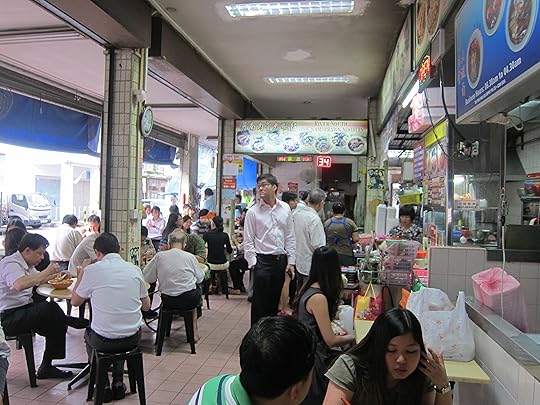 They’re more organized than most hawkers, so you order, get a number and wait. (You can see the flashing numbered board above.)
They’re more organized than most hawkers, so you order, get a number and wait. (You can see the flashing numbered board above.)
To quell our hunger (and impatience), we had an order of house-made fishcakes to start. I’m not a fan of eating fishcakes just by themselves but these — man — they are delicious. With just enough fishy flavor and the perfect level of sponginess, I could eat these fishcakes every day.
 The star of the show, of course, was the noodles. Hokkien prawn noodles — for those who have never tried them — are out of this world. And Hoe Nam is widely regarded as one of the best (if not the best) places to get them in Singapore.
The star of the show, of course, was the noodles. Hokkien prawn noodles — for those who have never tried them — are out of this world. And Hoe Nam is widely regarded as one of the best (if not the best) places to get them in Singapore.
For starters, Hoe Nam’s broth — made from boiling pork, pork bones and plump prawns with a bunch of spices — is packed with such intense and complex flavor and is so dense that you can practically chew it. You can see how dark it is below.
Second, the prawns here are huge and very fresh, due to the hawker’s high turnover. (And the fact that they pretty much sell only one thing.) You can get pork ribs and pig’s tails as well but I usually just stick with the prawns.
Third, the bright red chili powder inflected with prawn flavor that Hoe Nam serves to spice up your soups, is just delicious.
Finally, this big bowl will set you back just Singapore $5 (about U.S. $4) — how can you not love that?
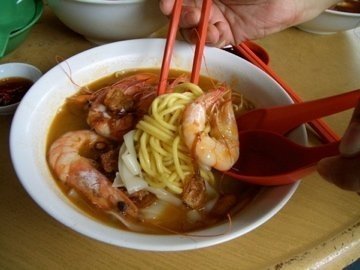
My only complaint about the place is that after waiting 30 minutes for your noodles, it’s usually gone in mere minutes. These past few days in New York though, what I wouldn’t have given for even one of those minutes.
River South (Hoe Nam) Prawn Noodles, 31 Tai Thong Crescent, Singapore; +65.6281.9293
February 7, 2013
Mongolian Buuz: A Perfect TV Snack
Eating in front of the telly is something that happens with some regularity in these parts.
When your partner is a super busy television critic, that tends to happen. And I’m certainly not averse to sitting down to lunch, dinner or brunch in front of the box. (A side of Downton Abbey with any meal? No problem at all.)
So when the Let’s Lunch crew decided on sharing perfect snacks for TV watching in our February posts, I knew I had to jump back in the fray.
What do we eat while watching something? Everything, really: Stews, noodles, omelettes, sandwiches. But I’ve learned that the ideal item is something compact — bite-sized and easy to pop in your mouth for a quick chew.
Which is what makes dumplings pretty much the perfect TV food …
Now, I’m no stranger to dumplings. I grew up in Singapore, land of wonton (or wanton, as we spell it) noodles for breakfast, after all. And I my Korean mother-in-law’s mandoo recipe remains one of my favorites in A Tiger in the Kitchen.
Recently, however, while spending a month on a mountain in Northern California holed up on a ranch and writing my second book, I had the great fortune of meeting a Mongolian artist who happened to know something about cooking. We were part of a small group of artists at the Djerassi Resident Artists Program — where we were given artists studios for a month and .
On Saturdays though, we were left on our own — an Indian artist showed us how to make chana masala one weekend; I whipped up a batch of Singaporean chicken satay another. Just when we thought the boys in the group didn’t have anything to teach in the kitchen, Tuguldur Yodonjamts asked if we liked Mongolian buuz.
It turns out that dumpling making crosses gender lines in Ulaanbaatar, where Togo’s from. “It’s like a competition,” he said, explaining that men and women would jab each other in the kitchen over which side could make more dumplings. (Ask him which side is better, however, and he just laughs.)
The process is simple — mix up ground beef with chopped scallions and onions. Then mix together a little vegetable oil with water, salt and pepper and pour that over the beef. You don’t want to add too much liquid — enough to make it firm but just a little mushy.
Next, mix all-purpose flour and water together in a large bowl, kneading until you form a dough. If you’ve ever made dumplings and felt dumpling skins before, you’ll know how the dough should feel — just slightly tacky but not sticky.
Them roll out the dough into long tubes like Togo is doing over here …
… then cut up those tubes into small pieces.
Next, toss those pieces (which are about slightly more than a tablespoon of dough) in flour.
Then, peel the label off a beer bottle and start rolling away.
You could use a rolling pin to do this but the circles you’ll get will be a little too evenly flat. What you want, Togo says, is a dough round that’s a little thicker in the middle, which is where the buuz filling goes. (If you use a beer bottle for rolling, you can control the movement a little better, rolling the circles from the outside in to ensure that the center is thicker.)
Once that’s done, put a little beef filling in the center, …
… press it down a little …
… and then start folding the dough inward in a circular motion.
At the end, you’ll have a little dough ball with an air pocket at the top — just so.
Our little group spent a lovely evening making dumplings together — I think you can tell which ones Togo made and which have the stamp of the rest of us amateurs.
When that was done, we popped them in the steamer for 10 minutes and we were ready to eat. (See above.)
And even if anything non-meat is very un-Mongolian, we even made some vegetarian versions stuffed with tofu and sweet potato.
I wish I could share Togo’s recipe but just like most great home cooks, he did this entirely by instinct and chuckled when I asked about a recipe.
Having tasted his buuz, though, I can tell you they’re out of this world. Bite-sized, juicy, delicious and addictive. Perfect for any afternoon in front of the telly.
~~~
Don’t forget to check out the Let’s Lunchers’ TV-worthy dishes below! And if you’d like to join Let’s Lunch, go to Twitter and post a message with the hashtag #Letslunch — or, post a comment below.
Annabelle‘s Idiazabal and Black Pepper Gougeres at Glass of Fancy
Emma‘s Korean and Curry Wings at Dreaming of Pots and Pans
Grace‘s Taiwanese Beef Sliders at HapaMama
Jill‘s Spiced Pecans at Eating My Words
Karen‘s Sporting Eats at GeoFooding
Linda‘s Trio of Salsas from Oaxaca at Spicebox Travels
Lisa‘s Sausage Rolls at Monday Morning Cooking Club
Lucy‘s Crabcakes with Chipotle Mayo and Citrus Salad at A Cook and Her Books
Rashda‘s Finger Lickin’ Good Curried Ribs at Hot Curries & Cold Beer
Renee‘s Shredded Sesame Chicken at My Kitchen and I
Sonja‘s Sticky Ginger Beer Chicken Wings at Foodnutzz
January 30, 2013
The Next Big Thing: A Preview
A lovely thing came out of writing my first book — I discovered a community of authors.
Through weeks-long residencies at artist colonies Yaddo and Djerassi, I lived with and learned from writers (and other artists) who listened to my stories and shared many of their own. All of this inevitably led to lasting friendships in which we’ve cheered one another on from coast to coast.
So when the talented and enormously entertaining Peter Mountford (my Yaddo mate as I holed up to write A Tiger in the Kitchen in 2010) invited me to join in on “The Next Big Thing Blog Hop,” I was most happy to oblige.
As Peter — author of A Young Man’s Guide To Late Capitalism — explained, this blog hop is a chance for authors to tell you what they’re working on. Authors answer 10 questions about their next book, tag the person who tagged them and at least five other authors. (You can read Peter’s piece about his second novel, The Dismal Science, here.)
Many thanks for the invite to the party, Peter. And here you all go — a sneak preview of what I’ve been cooking up in my little writing room …
What is your working title of your book (or story)?
I have two major projects on my plate right now. I’m editing my first fiction anthology — Singapore Noir, a collection of short stories set in Singapore that Akashic Books is publishing in Spring 2014. And I’m also working on my first novel – a story that clobbers my heart, makes me laugh (sometimes) and is the thing that nudges me to throw off the covers each morning so I can start my writing day. I can’t wait to share more about this novel when I can.
Where did the idea come from for the book?
Since I can’t discuss the novel yet, I’ll talk about Singapore Noir. I had long known of Akashic’s Noir prize-winning series — Dennis Lehane edited Boston Noir, Laura Lippman edited Baltimore Noir and here I am with author Kenneth Slawenski at the November 2011 launch of New Jersey Noir, edited by Joyce Carol Oates and featuring a fabulous story by the dashing Jonathan Santlofer (also pictured).
The very week after this photo was taken, I flew south to speak at the Miami Book Fair, where I found myself having cocktails with the awesome S.J. Rozan, who has written 12 novels and edited Bronx Noir. S.J. introduced me to the tall man next to her — Johnny Temple, head of Akashic — at which point I asked the question I’d been pondering: Why isn’t there a Singapore Noir?
Johnny’s answer was immediate: “Because I don’t know any writers from Singapore.”
To which, S.J. said: “Well, now you do.”
And that’s how Singapore Noir was born.
What genre does your book fall under?
Singapore Noir features very dark fiction from a country that many think of as clean, rigid and perhaps even a little boring. It’s true that Singapore is a bastion of modernity with very strict rules — you’ll probably remember the American kid who got sentenced to a caning in the 1990s for tagging cars with graffiti. But it’s also a densely packed city with a seamy side — one that will likely shock you as you wade through Singapore Noir.
Which actors would you choose to play your characters in a movie rendition?
I adore the gorgeous Maggie Q of Nikita, who sent me a sweet note after A Tiger in the Kitchen was published. So if any of the stories are turned into a film, I would hope that Maggie stars in it somehow!
What is the one-sentence synopsis of your book?
Gritty dark tales from the disturbing and deep underbelly of a seemingly pristine country.
Will your book be self-published or represented by an agency?
My amazing agent Jin Auh sold it to Akashic.
How long did it take you to write the first draft of your manuscript?
The manuscript is still in the works — more than a month ahead of deadline, however, I already have five of the 14 stories in and I’m thrilled to start reading them.
What other books would you compare this story to within your genre?
Certainly any of the other terrific books in Akashic’s Noir series but I’m hoping that this book will shed light on the intimate folkways of a lesser-known country much the way Haruki Murakami’s collections have shared Japan with us or Flannery O’Connor’s stories have shown us the Deep South.
Who or what inspired you to write this book?
As a native of Singapore, I’ve long been frustrated with the one-dimensional view that many have of the country. In the 20 years that I’ve lived in the United States, when I’ve mentioned Singapore, people have typically brought up caning and Draconian laws or asked whether it’s true that chewing gum is banned.
Having grown up in Singapore — and also having gotten to know it better in my repeated visits for research for Tiger and now the novel — I know the place is so much more complex. We have whole neighborhoods filled with streetwalkers, fatal machete attacks in public squares, a sad recent epidemic of suicides by train.
I hope Singapore Noir will delve into the darker side of my country, which the world largely hasn’t seen. And yes, I’ll have a story in it, too.
What else about your book might pique the reader’s interest?
Many of the authors of stories for Singapore Noir have never been published outside of Singapore. And these are some of the region’s best writers — four of them, for example, have won the Singapore Literature Prize, which is the country’s equivalent of the Pulitzer Prize in the U.S.
Ovidia Yu, one of Singapore’s leading playwrights, just turned in her evocative piece. You’ll also hear from prizewinners Suchen Christine Lim, Philip Jeyaratnam, Simon Tay and Colin Cheong. And also Johann S. Lee — author of Peculiar Chris, Singapore’s first gay-themed novel — who is an inspiration for many in a country in which homosexual sex remains illegal.
Additionally, some incredible international writers have signed on to write pieces as well — the list includes Jeet Thayil, whose lyrical novel Narcopolis was shortlisted for the Booker last year, and Lawrence Osborne, whose latest novel The Forgiven has been earning rave reviews worldwide, just to name a few.
Here’s to sharing Singapore Noir with you in 2014!
And now to tag a few folks. Next up:
Lisa Takeuchi Cullen, a lovely former colleague at Time Inc. not so many moons ago when we were both fulltime journalists. Her first novel Pastors’ Wives comes out in April and she just sold her first drama pilot, The Ordained, to CBS. And…
Gordon Dahlquist, a playwright and novelist who is my trusted reader of first drafts and very dear friend. Gordon wrote the terrific The Glass Books of the Dream Eaters fantasy trilogy and his first young adult novel The Different Girl comes out February 21. And…
James Iver Mattson, screenwriter (Deliver Us From Eva) and incredible copper artist, whose first middle-grade book — co-written with Barbara Brauner — comes out in May. The Glitter Trap is the first of four in their Oh My Godmother series. Very exciting! And…
Nova Ren Suma, the super sweet young adult author extraordinaire of Imaginary Girls and Fade Out, whose third novel 17 & Gone comes out in March. And…
Neal Thompson, one of my favorite people and former colleagues who’s written three books. His fourth – A Curious Man: The Strange and Brilliant Life of Robert “Believe It or Not!” Ripley – comes out in May. And…
Joe Yonan, fabulous food editor at The Washington Post, Let’s Lunch friend and author of the terrific cookbook Serve Yourself: Nightly Adventures in Cooking For One. Joe’s second book Eat Your Vegetables: Bold Recipes For The Single Cook comes out in August.
Cheryl Lu-Lien Tan's Blog
- Cheryl Lu-Lien Tan's profile
- 76 followers


